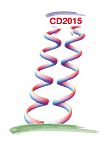Speaker
Harald W. Griesshammer
(George Washington University, Washington)
Description
Compton scattering from protons and neutrons probes the two-photon response of the nucleon in electric and magnetic fields at fixed photon frequency and multipolarity [1]. It provides detailed tests of the symmetries and strengths of the interactions of the nucleonic constituents with each other and with photons. Proton-neutron differences explore the interplay between chiral symmetry breaking and short-distance Physics. At low energies, the process is parametrised by six energy-dependent dipole polarisabilities. For convenience, the information is however often compressed into the two scalar dipole polarisabilities αE1 and βM1 at the static point. In combination with emerging lattice QCD determinations, they provide stringent tests for our theoretical description of hadron structure. A plenary talk by J. A. McGovern discusses new high-accuracy extractions of the proton and neutron static electric and magnetic scalar dipole polarisabilities from all published elastic data below 300 MeV in Chiral EFT with explicit ∆(1232) degrees of freedom and model-independent estimates of higher-order corrections [2,3].
This contribution addresses opportunities for χEFT to serve as intermediary between first-principle calculations in lattice QCD and efforts which are ongoing or approved at MAX-lab, HIγS and MAMI (cf. E. Downie’s plenary talk). Such high-intensity experiments with polarised targets and polarised beams allow the extraction not only of scalar polarisabilities, but in particular of the so-far poorly explored spin-polarisabilities which parametrise the stiffness of the nucleon spin in external electro-magnetic fields (nucleonic bi-refringence/Faraday effect). New chiral predictions for a comprehensive study of proton, deuteron and 3He observables extend the analysis to higher energies and higher orders and help to better determine spin and neutron polarisabilities [4,5]. They also serve to relate emerging lattice QCD simulations at m_π > 200 MeV to data at the physical point. In chiral lattice extrapolations, the relative theoretical uncertainties increase with m_π: the magnitudes of the polarisabilities decrease; the χEFT expansion parameter itself increases; and the ∆(1232) becomes more important, leading to a re-ordering of contributions. We quantify such uncertainties using a widely applicable method and compare to existing simulations [6].
References
1. H. W. Grießhammer, J. A. McGovern, D. R. Phillips and G. Feldman, Prog. Part. Nucl. Phys. 67 (2012) 841.
2. J. A. McGovern, D. R. Phillips and H. W. Grießhammer, Eur. Phys. J. A49 (2013) 12.
3. L. S. Myers et al., Phys. Rev. Lett. 113 (2014) 262506.
4. H. W. Grießhammer, Eur. Phys. J. A49 (2013) 100.
5. B. Sandberg, H. W. Grießhammer, J. A. McGovern and D. R. Phillips, forthcoming.
6. H. W. Grießhammer, J. A. McGovern and D. R. Phillips, forthcoming.
Primary author
Harald W. Griesshammer
(George Washington University, Washington)

